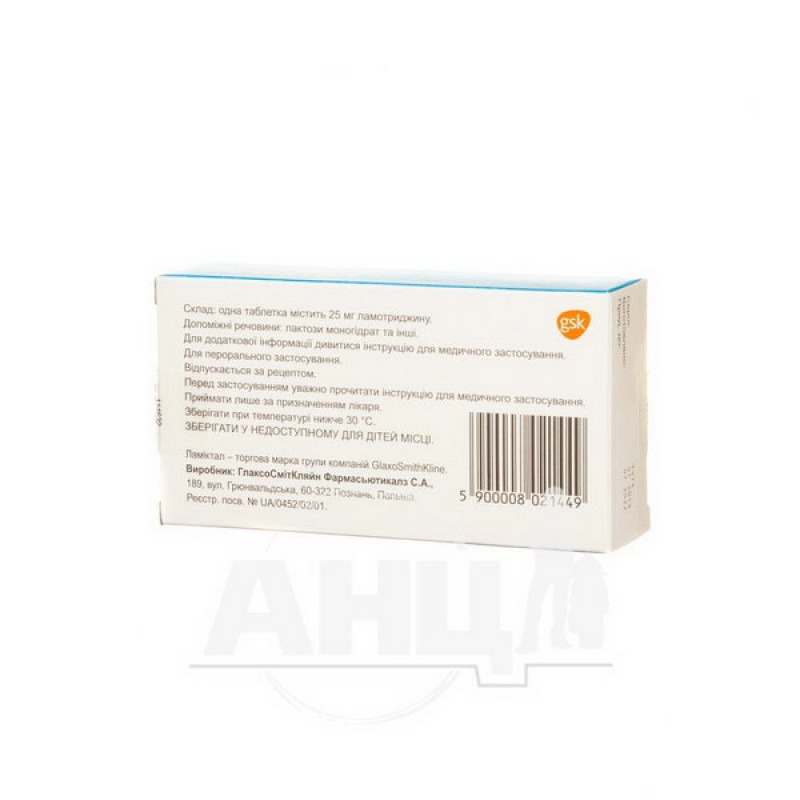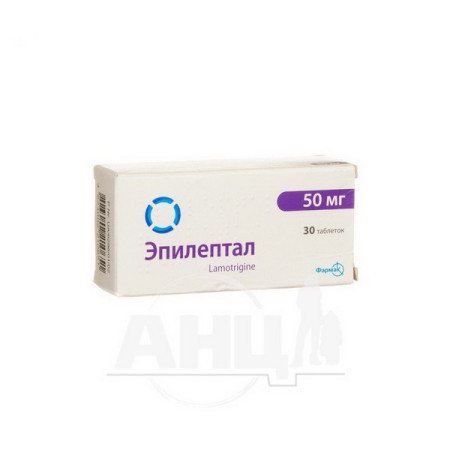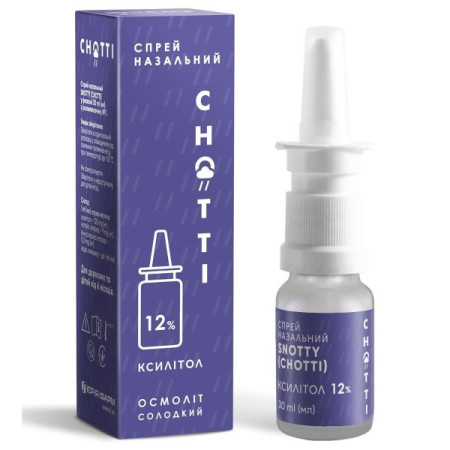Lamictal tablets 25 mg No. 30

Lamictal™ tablets are used for the indications listed below.
epilepsy:
Adults and children aged 13 years and over: adjunctive therapy or monotherapy for partial and generalized epileptic seizures, including tonic-clonic seizures; seizures associated with Lennox-Gastaut syndrome (Lamictal™ is prescribed as adjunctive therapy, but in Lennox-Gastaut syndrome it can be prescribed as an initial antiepileptic drug (AED)); Children aged 2 to 12 years: adjunctive therapy for partial and generalized epileptic seizures, including tonic-clonic seizures and seizures associated with Lennox-Gastaut syndrome; monotherapy for typical absences.Bipolar disorder (adults - from 18 years of age): prevention of depressive states in patients with bipolar I disorder, who mainly suffer from depressive states ("Lamictal ™" is not indicated for the emergency treatment of manic or depressive episodes).
Composition
The active substance is lamotrigine (one tablet contains lamotrigine 25 mg).
Excipients: lactose monohydrate, microcrystalline cellulose, povidone K30, sodium starch glycolate (type A), yellow iron oxide (E172), magnesium stearate.
Contraindication
Lamictal™ is contraindicated in patients with known hypersensitivity to lamotrigine or any other component of the drug.
Method of application
Lamictal™ tablets should be swallowed whole, without chewing or breaking.
If the calculated dose of lamotrigine (for example, for the treatment of children suffering from epilepsy or patients with impaired liver function) is not a multiple of whole tablets, the dose used should correspond to the nearest smaller number of whole tablets.
Restarting treatment
Physicians should consider increasing the dose to maintenance when resuming Lamictal™ in patients who have discontinued Lamictal™ for any reason, as the risk of serious rash is associated with high initial doses and exceeding the recommended dose escalation schedule for lamotrigine. The longer the time interval since the previous dose, the more careful consideration should be given to increasing the dose to maintenance. If the interval since discontinuation of lamotrigine exceeds five half-lives, the dose of Lamictal™ should be increased to maintenance according to the existing schedule. Resuming Lamictal™ is not recommended for patients who have discontinued due to rash associated with previous Lamictal™ therapy, unless the potential benefit of treatment clearly outweighs the risk.
Epilepsy
The recommended dose escalation and maintenance doses for adults and children 13 years of age and older, and for children 2 to 12 years of age, are as follows. The initial dose and rate of further dose escalation should not be exceeded due to the risk of rash.
When concomitant AEDs are withdrawn or other AEDs/drugs are added to lamotrigine-containing regimens, the effect they may have on lamotrigine pharmacokinetics should be considered.
Recommended epilepsy treatment regimens for adults and children aged 13 and over:
monotherapy: 1st + 2nd week - 25 mg/day (one dose); 3rd + 4th week - 50 mg/day (one dose); usual maintenance dose - 100-200 mg/day (one or two doses) (to achieve a maintenance dose, it should be increased by a maximum of 50-100 mg every one or two weeks until an optimal response is achieved, some patients require a dose of 500 mg/day to achieve the desired response); additional therapy with valproate (an inhibitor of lamotrigine glucuronidation) (this treatment regimen involves the use of valproate, despite the use of other concomitant medications): 1st + 2nd week - 12.5 mg/day (take 25 mg every other day); 3rd + 4th week - 25 mg/day (one dose); usual maintenance dose - 100-200 mg/day (one or two doses) (to achieve the maintenance dose, it should be increased by a maximum of 25-50 mg every one or two weeks until the optimal response is achieved); additional therapy without the use of valproate and with the use of inducers of lamotrigine glucuronidation (this treatment regimen does not involve the use of valproate, but involves the use of: phenytoin, carbamazepine, phenobarbital, primidone, rifampicin, lopinavir / ritonavir): 1st + 2nd week - 50 mg/day (one dose); 3rd + 4th week - 100 mg/day (two doses); usual maintenance dose - 200-400 mg/day (two doses) (to achieve a maintenance dose, it should be increased by a maximum of 100 mg every one or two weeks until an optimal response is achieved, some patients require a dose of 700 mg/day to achieve the desired response); additional therapy without the use of valproate and inducers of lamotrigine glucuronidation (this treatment regimen involves the use of drugs that do not show a significant inhibitory or inducing effect on liver enzymes): 1st + 2nd week - 25 mg/day (one dose); 3rd + 4th week - 50 mg/day (one dose); usual maintenance dose - 100-200 mg/day (one or two doses) (to achieve a maintenance dose, it should be increased by a maximum of 50-100 mg every one or two weeks until an optimal response is achieved).Recommended epilepsy treatment regimen for children aged 2 to 12 years:
monotherapy of typical absence seizures: 1st + 2nd week - 0.3 mg/kg/day (one or two doses per day); 3rd + 4th week - 0.6 mg/kg/day (one or two doses per day); usual maintenance dose - 1-15 mg/g/day (one or two doses per day) (to achieve a maintenance dose, it should be increased by a maximum of 0.6 mg/kg/day every one or two weeks until an optimal response is achieved, maximum maintenance dose - 200 mg/day); additional therapy with valproate (an inhibitor of lamotrigine glucuronidation) (this treatment regimen involves the use of valproate, despite the use of other concomitant medications): 1st + 2nd week - 0.15 mg/kg/day (one dose per day); 3rd + 4th week - 0.3 mg/kg/day (once daily); usual maintenance dose - 1-5 mg/kg/day (once or twice daily) (to achieve the maintenance dose, it should be increased by a maximum of 0.3 mg/kg/day every one or two weeks until the optimal response is achieved, the maximum maintenance dose is 200 mg/day); additional therapy without the use of valproate and with the use of lamotrigine glucuronidation inducers (this treatment regimen does not involve the use of valproate, but involves the use of phenytoin, carbamazepine, phenobarbital, primidone, rifampicin, lopinavir/ritonavir): 1st + 2nd week - 0.6 mg/kg/day (twice daily); 3rd + 4th week - 1.2 mg/kg/day (twice daily); usual maintenance dose - 5-15 mg/kg/day (one or two doses) (to achieve the maintenance dose, it should be increased by a maximum of 1.2 mg/kg/day every one or two weeks until the optimal response is achieved, the maximum maintenance dose is 400 mg/day); additional therapy without the use of valproate and inducers of lamotrigine glucuronidation (this treatment regimen involves the use of drugs that do not have a significant inhibitory or inducing effect on liver enzymes): 1st + 2nd week - 0.3 mg/kg/day (one or two doses); 3rd + 4th week - 0.6 mg/kg/day (one or two doses); The usual maintenance dose is 1-10 mg/kg/day (in one or two divided doses) (to achieve the maintenance dose, it should be increased by a maximum of 0.6 mg/kg/day every one or two weeks until an optimal response is achieved, the maximum maintenance dose is 200 mg/day).Patients taking medications with unknown effects on the pharmacokinetics of lamotrigine should use the treatment regimen recommended for concomitant use of lamotrigine and valproate.
To ensure maintenance of the therapeutic dose, the child's body weight should be monitored and the dose adjusted as weight changes. Patients aged two to six years are likely to require a maintenance dose closer to the upper end of the recommended range.
If epileptic control is achieved with adjunctive therapy, concomitant AEDs can be discontinued and monotherapy with Lamictal™ can be continued.
Children under 2 years of age. Data on the efficacy and safety of lamotrigine as adjunctive therapy for partial onset seizures in children aged 1 month to 2 years are limited. There are no data on the use of lamotrigine in children under 1 month of age. Therefore, Lamictal™ is not recommended for use in children under 2 years of age.
Bipolar disorder
Recommended dose escalation schedule to achieve a maintenance stabilization daily dose in the treatment of bipolar disorder in adults (over 18 years of age):
lamotrigine monotherapy or adjunctive therapy without the use of valproate and inducers of lamotrigine glucuronidation (this treatment regimen involves the use of drugs that do not exhibit a significant inhibitory or inducing effect on liver enzymes): 1st + 2nd week - 25 mg/day (one dose); 3rd + 4th week - 50 mg/day (one or two doses); 5th week - 100 mg/day (one or two doses); target stabilization dose (6th week) - 200 mg/day - the usual target dose to obtain an optimal response (one or two doses) (doses in the range of 100-400 mg/day were used in clinical studies); adjunctive therapy with valproate (lamotrigine glucuronidation inhibitor) (this treatment regimen involves the use of valproate, despite the use of other concomitant medications): 1st + 2nd week - 12.5 mg/day (25 mg every other day); 3rd + 4th week - 25 mg/day (one dose); 5th week - 50 mg/day (one or two doses); target stabilization dose (6th week) - 100 mg/day - the usual target dose for optimal response (one or two doses) (a maximum dose of 200 mg/day can be used depending on the clinical response); additional therapy without the use of valproate and with the use of lamotrigine glucuronidation inducers (this treatment regimen does not involve the use of valproate, but involves the use of phenytoin, carbamazepine, phenobarbital, primidone, rifampicin, lopinavir/ritonavir): 1st + 2nd week - 50 mg/day (one dose); 3rd + 4th week - 100 mg/day (two doses); 5th week - 200 mg/day (two doses); target stabilization dose (6th week) - 300 mg/day at week 6, if necessary, the usual target dose of 400 mg/day is increased at week 7 to achieve optimal response (two doses).Patients taking medications with unknown effects on the pharmacokinetics of lamotrigine should use the dose escalation regimen recommended for co-administration of lamotrigine with valproate.
Maintenance stabilization daily dose after discontinuation of concomitant medications for the treatment of bipolar disorder in adults (18 years and older). Once the required maintenance stabilization dose is reached, other psychotropic medications may be discontinued according to specific schedules.
Children (under 18 years of age): This drug is not recommended for use in children with bipolar disorder (under 18 years of age) because randomized withdrawal studies have not demonstrated significant efficacy and have shown an increase in suicidality.
Application features
Pregnant women
A large amount of data on pregnant women exposed to lamotrigine monotherapy during the first trimester of pregnancy (more than 8700) do not indicate a significant increased risk of serious congenital malformations, including oral clefts. If therapy with Lamictal ™ is considered necessary during pregnancy, it is recommended to use it at the lowest possible therapeutic dose.
Lamotrigine has been reported to pass into breast milk in varying concentrations, resulting in total lamotrigine concentrations in the infant that may be approximately 50% of the lamotrigine concentration recorded in the mother. Thus, in some breastfed infants, serum lamotrigine concentrations may reach levels at which pharmacological effects are evident. The potential benefit of breastfeeding should be weighed against the risk of adverse effects in the infant. If a woman receiving lamotrigine therapy decides to breastfeed, the infant should be closely monitored for adverse effects such as sedation, rash, and failure to thrive.
Animal studies have not shown any effect of lamotrigine on fertility.
Drivers
Two studies in volunteers found that the effects of lamotrigine on visual coordination, eye movement, body control and subjective sedation were not different from those of placebo. Neurological adverse reactions such as dizziness and diplopia have been reported with lamotrigine in clinical trials, so patients should first assess their own response to lamotrigine treatment before driving or operating machinery. Since there is an individual response to antiepileptic drugs, the patient should consult a doctor regarding the specifics of driving in these cases.
Overdose
Symptoms and signs
There have been reports of acute overdose (doses 10-20 times the maximum therapeutic dose), including fatalities. Symptoms of overdose have included ataxia, nystagmus, impaired consciousness, grand mal seizures, and coma. QRS complex widening (intraventricular conduction delay) has also been reported in overdose. QRS complex widening to >100 msec may be associated with more severe toxicity.
In case of overdose, the patient should be hospitalized for appropriate supportive therapy. Absorption-reducing therapy (activated charcoal) should be used if necessary. Additional treatment should be given as clinically indicated. There is no experience with hemodialysis in the treatment of overdose. In six volunteers with renal failure, 20% of lamotrigine was removed from the body during a 4-hour hemodialysis session.
Side effects
Psychiatric disorders: very common (≥ 1/10) - aggression, irritability.
From the nervous system: very often (≥ 1/10) - headache; often (≥ 1/100, <1/10) - drowsiness, dizziness, tremor, insomnia, anxiety.
Gastrointestinal: often (≥ 1/100, <1/10) - nausea, vomiting, diarrhea, dry mouth.
Skin and subcutaneous tissue disorders: very common (≥ 1/10) - skin rash.
Musculoskeletal and connective tissue disorders: common (≥ 1/100, <1/10) - arthralgia.
Storage conditions
Store below 30°C, out of the reach of children.
Shelf life - 3 years.
There are no reviews for this product.
There are no reviews for this product, be the first to leave your review.
No questions about this product, be the first and ask your question.
















